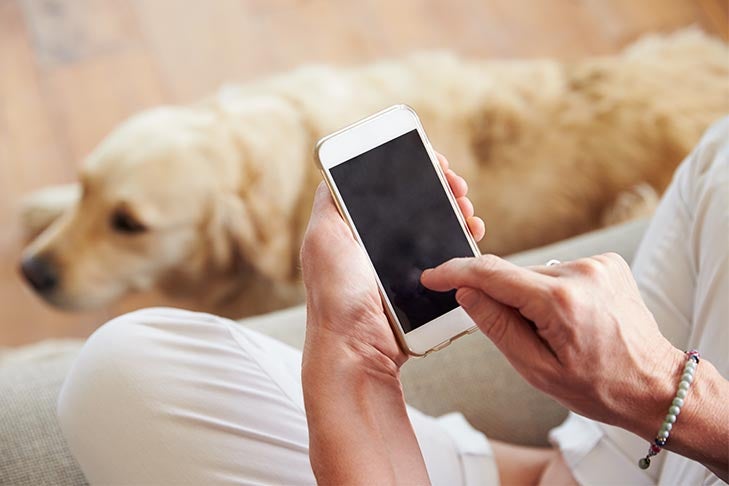
“HOLD STILL!”
Telemedicine sounds easy—talk to your vet, never leave your armchair. And sometimes it is. But sometimes it isn’t.
Like now. Have you ever tried holding your dog while pulling his lips back to expose his rearmost molars while at the same time trying to aim your cell-phone camera at the tooth in question? Using just the three hands you were born with? All while not cursing loud enough for the microphone to hear? Just another challenge in this day of COVID-19 isolation as I tried to show Pepe’s suspect tooth to my veterinarian—my first telemedicine appointment!
“The veterinarian will need to see him … ” has always been the standard reply BC (Before COVID-19), whether the question was “My dog has tapeworms—can I get some worm meds?” or “He burped—could he have bloat?” And it still is, sort of—only now the veterinarian can see him without you leaving home. At least sometimes. Pepe did end up having to go in for a visit, but at least we tried to “stay-at-home” first.
App Time
Telemedicine for humans has been gently nudging veterinary medicine to follow suit for years, with slow progress. The COVID-19 crisis has replaced that gentle nudge with a boot to the backside, thrusting telemedicine into thousands of practices and homes across the country. Sure, some sort of telemedicine has been in place for years, if you count the telephone follow-ups or quick questions. But there are drawbacks to this traditional, informal type of telemedicine.
For starters, informal phone calls can get out of hand. A “quick question” morphs into 20 minutes of “just one more thing.” As much as your veterinarian wants to be helpful, she can’t afford to spend her days as a free advice line, or worse, lonely hearts club member. For another, there’s the possibility of miscommunication. Not every client takes great notes over the phone. To combat that, the veterinarian must transcribe her advice, again adding to the time factor. And notes must be added to the patient’s record—all of which happen “off the clock” as far as the client is concerned.
That’s where telemedicine apps come in. Depending on the app, they can automatically bill the client by the session or by 10- or 20-minute increments, allow for two-way messaging or video chatting, and make available a record of the transcript or session. It also allows you to perform a number of add-ons, like scheduling appointments and refilling prescriptions—all within a private and secure system. About 15 such apps are now serving veterinary practices in the United States. One of the largest, PetDesk, has seen a 300 percent increase in their two-way messaging volume since the crisis began, according to spokesperson Christine Gately-Evans. “Last week we surpassed 47,000 messages in a single week and our per-clinic message volume has increased 47 percent since March 16,” she says.

Legal Limits
Lori Teller, DVM, DABVP, heads the telehealth program at Texas A&M College of Veterinary Medicine. She reports that the popularity of veterinary telemedicine has grown exponentially since their telehealth program started just a few weeks before the pandemic broke out. She cautions that telemedicine isn’t for every case. And don’t expect to start with a new clinic just because they offer telemedicine. A Veterinary-Client-Patient-Relationship (VCPR) has long been a legal requirement before a veterinarian can treat any dog or dispense any medication. That means that, by law, a veterinarian must physically examine your dog, usually within a year or so, and keep records of the dog. “Many states have temporarily waived the physical exam requirement for establishing a VCPR, but not most states,” Teller explains. “A VCPR is still a requirement in almost every jurisdiction. However, several states are allowing the VCPR to be established remotely (via telemedicine) in order to meet the needs of the owners and their pets, while addressing the needs of the public to maintain social distancing. … The FDA and the DEA have also temporarily relaxed some of their requirements about establishing the VCPR with regards to prescribing certain medications.”
Telemedicine may seem like the wave of the future, but it has its limitations. It’s best used as a triage—determining if it’s an emergency situation, whether a pet needs to come to the clinic at all—or as a follow-up. Sharon Lomnicki, DVM, recently integrated telemedicine at her Cape Coral Veterinary Clinic in Cape Coral, Florida, because of the COVID-19 situation. “I can’t do blood work, or listen to a heart through the computer, nor can I diagnose the cause of vomiting,” she cautions. “But I have looked inside an ear, checked on the progress of a skin condition, and counted respirations.” Although she hasn’t yet had the cause, she adds that she could also look at gum color or capillary refill time, and even do a visual exam of a urine sample.
A Good Dog Helps
Assuming, of course, a cooperative patient. (Read: Not Pepe). That’s another drawback of telemedicine: You never realize how vital a vet tech is until you don’t have one to help. Also, there’s a tendency to focus on just the issue as defined by the owner—or where the owner aims the camera—so it’s easy to miss another seemingly unrelated cause or problem. And owners who aren’t computer savvy must practice using a camera, speaker, and microphone before an appointment, and possibly downloading an app. Ideally, they should do it now, before an emergency could arise when they’d need it.
While not perfect, the advantages of veterinary telemedicine still outweigh the disadvantages (unless you factor in my frenzied cleaning session so the vet wouldn’t see my messy house in the background). You know how your sick dog is suddenly the picture of health once he’s at the vet? Now the vet can see what you see while he’s in his home environment. And if you have a dog who’s stressed out at the vet’s office, here’s his chance for a fear-free “visit.” Not only is that good for the dog, but it’s nice for your vet to finally see your dog’s personality at home. Teller chuckles recalling a Bulldog who got very excited hearing people talk about her over the computer. “The client was using treats to try to get the dog to sit still, and the Bulldog ended up kissing the camera!”
But then, what about all those real kisses that will never land on the vet’s cheeks? Maybe one day, there’ll be an app for that.
Caroline Coile is the author of more than 30 books about dogs and is a two-time AKC Canine Health Foundation Award winner.
 Originally appeared in the July/August 2020 issue of AKC Family Dog.
Originally appeared in the July/August 2020 issue of AKC Family Dog.
The AKC is here to help owners with questions and concerns about COVID-19 and dogs. Find answers to your questions, plus at-home activity ideas, training tips, educational resources, and more on our Coping With COVID-19 hub.

